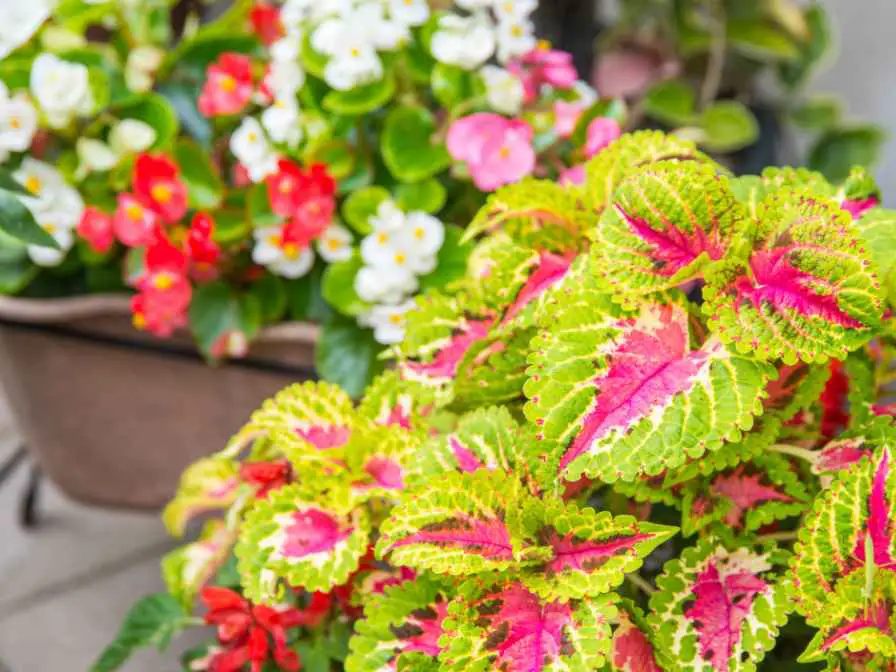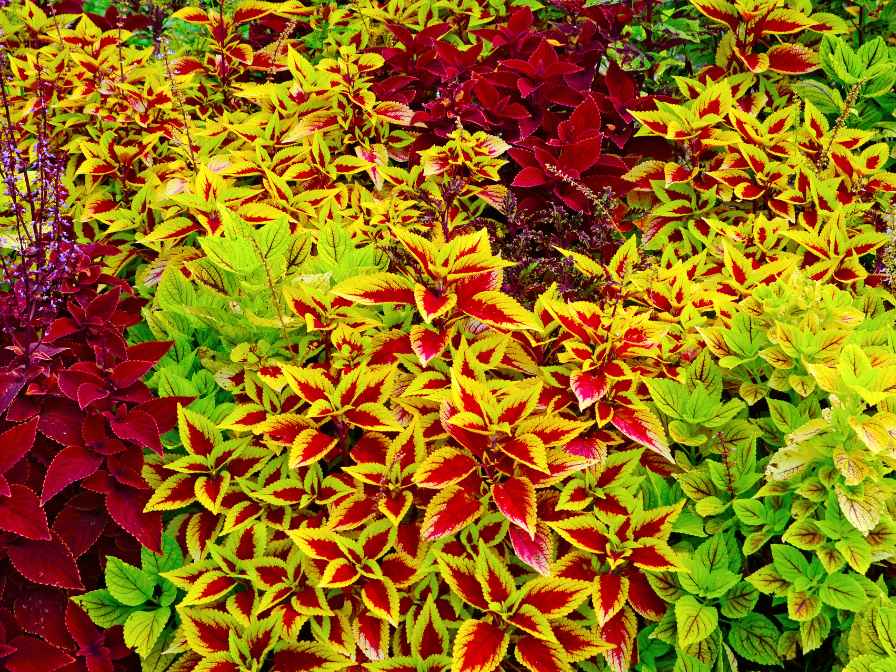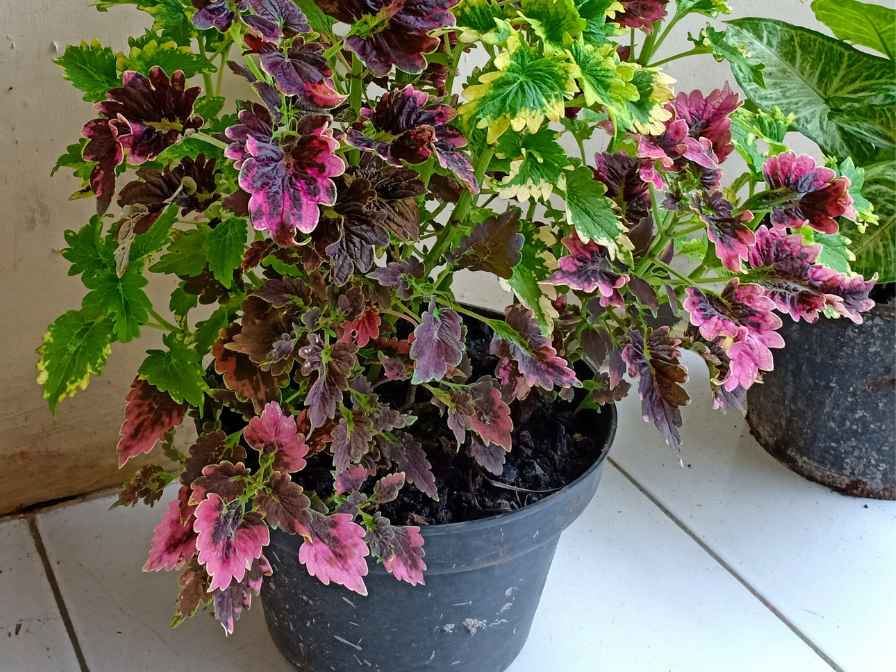What to plant as a companion plant? A common question arises when we have lesser space available. And when this practice is to be done in a container, then it becomes more important because it comes with high stakes. That’s why we are going to discuss what to plant with coleus in a container.

Coleus plants
Coleus is a species of plant in the Lamiaceae family that are commonly grown for its brightly colored foliage in garden beds and containers. They are native to tropical regions of Asia and Africa and are known for their showy leaves which come in many colors like purple, red, pink, yellow, and green.
Coleus is relatively easy to care for and prefers well-drained soil and partial shade. They don’t need full sun exposure to grow well. However, the coleus plants are very good-looking, but they are poisonous and harmful to pets and humans. As they don’t need enough sunlight, these can be planted in both outdoor and indoor settings.
Why plant coleus plant?
As belonging to the mints family of the Lamiaceae family, these herbs do have a lot of benefits to plant. Some of the important ones that are preferred by the people are as follow:
Colorful foliage
Coleus plants are prized for their vibrant and colorful foliage, which can add a pop of color to your garden or indoor spaces. That is the main reason for planting the coleus in the garden or the container settings.
Easy to grow
They don’t need much sunlight, and that’s why these plants remain moist. This moisture helps in easy care of the coleus. These are low maintenance and easy to grow.
Versatility
Coleus plants can be grown as annuals or perennials, depending on the climate, and can be used in a variety of garden settings, including containers, hanging baskets, and borders. Their versatile usage has made these plants a very much preferred herb.
Heat tolerance
In warmer climates, coleus plants are known for their heat tolerance, making them a great choice for summer gardens. The hotter the temperature, the well they do. They can survive in quite a good heat.
Air-purifying

According to some studies done by experts, coleus can help in air purification of the environment. While some scientist does think it is not the matter. But the important is they look good and they make the environment clean and fresh.
Overall, coleus plants are a great choice for adding color and interest to your garden or indoor spaces, and they are relatively easy to care for and maintain. You just need to make sure that you plant it according to instructions.
Companion planting
Companion planting is the practice of growing different plant species close to each other for mutual benefit. This can be achieved by either enhancing plant growth, repelling pests and diseases, or improving soil fertility.
Examples of common companion plants are tomatoes and basil, which can help improve the flavor of tomatoes, and marigolds, which can help repel pests like nematodes in the soil. you can say these pants act as complementary plants to each other. They do support each other in good growth.
Benefits and importance of companion panting
There are many benefits of companion planting. It is a standard practice that is followed in the planned gardens. It not only adds plants to the garden but also adds value to it. These plants act complementary to each other. Some of the benefits are as follows:
Pest control
Certain plants have the ability to repel pests, protect other plants from disease, or attract beneficial insects that can help control pests. Like they help in cross-pollination by attracting useful insects and bees. They also repel harmful insects.
Improved soil health
Companion plants can improve soil fertility by adding nitrogen and other nutrients to the soil, reducing erosion and improving water retention. Some plants like beans draw a good amount of nitrogen from the air, it submits it to the ground.
Increased yields:
Companion planting can improve the growth and yields of certain crops by providing shade, reducing competition for light, water, and nutrients, or attracting pollinators. Also, the companion plants act as a shelter for the others.
Reduced need for chemical pesticides
Companion planting can help reduce the need for chemical pesticides, as some plants have natural pest-repelling properties. Some plants act as a decoy for the other plants. They keep harmful pests, wild animals, and birds away from the plants.
Biodiversity
Companion planting can increase biodiversity in the garden, creating a healthier and more dynamic ecosystem. All of the plant act as crucial for one another. They build an ecosystem, which is both healthier and safer for all of the plants in the garden.
In short, companion planting is a useful tool for organic gardening that can improve the health and productivity of plants, while reducing the negative impact of chemical pesticides on the environment. It is a win-win situation for the gardener as there are more plants as well as safer and healthier.
What to Plant with Coleus in a Container?

Coleus is a versatile and colorful plant that pairs well with many other plants in container gardens or borders. There are plants that can be planted with the coleus in a container, making it mutually beneficial. Some of the most popular companion plants for coleus include:
Impatiens
Impatiens add color and texture to a container garden, and they also enjoy similar growing conditions to coleus. These plants have a wide range of colors. You can choose any of those which are matching to coleus as well. These plants are perennial in nature.
Calibrachoa
These petite, bright-colored annuals are a popular choice for pairing with coleus because they provide an attractive contrast of color and form. These are known as evergreen plants. You can get it in many colors. Like the coleus, it can grow in partial shades effectively.
Begonia
Begonias are a classic companion plant for coleus, with their contrasting foliage and colorful flowers. It has many different colors and shades. You can choose any of these. Like coleus, it grows well in the shade and acts as a good companion plant for coleus.
Sweet Potato Vine
The lush, trailing foliage of sweet potato vine adds a tropical touch to containers and provides an excellent contrast to the upright growth habit of coleus. They produce beautiful flowers as well as sweet potatoes in the fall.
Ferns
Ferns are a good companion for coleus because they prefer the same growing conditions and provide a different texture to the planting. These are ornamental plants, with no seeds and flowers just spreading from the spores.
It’s important to keep in mind the growing conditions and requirements of each plant, such as light, water, and soil when choosing companion plants for coleus. Most of the above-mentioned plants usually grow in almost the same conditions as coleus.
Cautions while choosing and Planting Companion Plants
Although companion planting is a very good practice and should be done to make good use of land and keep the plants healthy and safe with minimal cost. Here are some of the cautions as follows:
Make sure the companion plants have compatible growing conditions, such as light, water, and soil requirements. They should not have contrast in them. It might hurt any one of the plants.
Be aware of the mature size and growth habits of each plant, so they don’t become overcrowded or compete for resources. Like any one of the plants can get the space of the other, causing hindrance n growth.
Some plants can become invasive and take over the garden, so choose carefully and be prepared to remove any that become problematic. Prune them regularly to keep the in shape and in control.
Keep in mind any potential allopathic effects, where one plant may release chemicals that inhibit the growth of other plants. The selected plants should support each other in all possible ways.
Consider the seasonality of plants, so they complement each other in terms of appearance and growth cycle. It may not be the case that one plant is in a dwarf season, and the other is in the bloom season. They may create a beneficial edge for each other in that case.
Pesticides and other treatments used on one plant may harm companion plants, so be mindful of this when applying any treatments to your garden. It may harm other plants and burn them to the ground.
In a nutshell, companion planting is such a practice that if it is carefully planned and executed, the plants will be beneficial to each other. The same goes for the coleus plants. You will get a good ornamental plant with mutually benefiting plants.

